Contagious Disease
Page 2 of 3
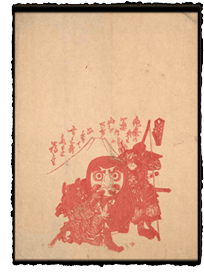 An anonymous hōsō-e in the collection
represents another interesting variation on this theme. At center is a life-sized red Daruma toy, supported on either side by
a warrior: to the left is Shōki, recognizable through his Chinese-style
costume; and on the right is the archer Tametomo. The toy, with its rounded
bottom and distinctive red-hooded head, is derived from the famous Zen
patriarch Daruma (Skt. Bodhidharma, active 6th c.). An anonymous hōsō-e in the collection
represents another interesting variation on this theme. At center is a life-sized red Daruma toy, supported on either side by
a warrior: to the left is Shōki, recognizable through his Chinese-style
costume; and on the right is the archer Tametomo. The toy, with its rounded
bottom and distinctive red-hooded head, is derived from the famous Zen
patriarch Daruma (Skt. Bodhidharma, active 6th c.).
An Indian monk who
brought the precepts of Chan (Zen) Buddhism to China, Daruma famously spent so
long in seated meditation that his legs atrophied, and his eyelids fell away —
hence the doll's unblinking gaze. That
the dolls return to their upright position after being tilted symbolizes the
qualities of determination and steadfastness, embodied in Bodhidharma's story. The combined attributes of a red robe and
watchful gaze may have led Daruma to be regarded as one who could be called
upon to protect children against smallpox.
Behind the trio in this hōsō-e is a simple linear
rendering of Mt. Fuji's conical peak. Japan's
foremost sacred mountain, Mt.
Fuji was also deemed a
protective hōsōgami. Popular
saying likened the raised form of a smallpox scab — a sign of imminent recovery
— to the mountain's characteristic shape.
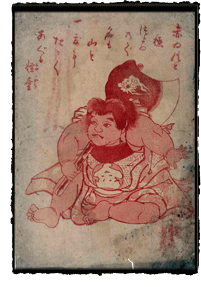 A second hōsō-e depicts the hero
Kintarō as a muscular baby wearing a bib emblazoned with the first
character from his name, kin (gold). Over his shoulder he carries the
giant hatchet that accompanies him everywhere — like Hercules' club, a potent
symbol of his strength and bravery. Like
Daruma in the previous image, the boy's gaze is direct and steadfast, as he
casts a protective eye on his surroundings. A second hōsō-e depicts the hero
Kintarō as a muscular baby wearing a bib emblazoned with the first
character from his name, kin (gold). Over his shoulder he carries the
giant hatchet that accompanies him everywhere — like Hercules' club, a potent
symbol of his strength and bravery. Like
Daruma in the previous image, the boy's gaze is direct and steadfast, as he
casts a protective eye on his surroundings.
The two previous
examples were produced before 1849, when the smallpox vaccine was introduced
into Japan. Several smallpox handbills, or hikifuda, preserved in the UCSF
collection suggest how woodblock prints were used in the campaign to encourage
people to replace their folk beliefs with confidence in a scientifically proven
means of avoiding the disease.
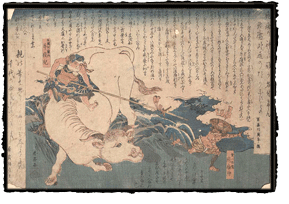 Prints such as these
were distributed as a means of addressing recurring doubts about the vaccine's
safety. Cow-related imagery is prevalent
in the handbills as part of a response to fears that since the first vaccines
employed a strain of cowpox, people might somehow be transformed into cows if
they agreed to be vaccinated. Prints such as these
were distributed as a means of addressing recurring doubts about the vaccine's
safety. Cow-related imagery is prevalent
in the handbills as part of a response to fears that since the first vaccines
employed a strain of cowpox, people might somehow be transformed into cows if
they agreed to be vaccinated.
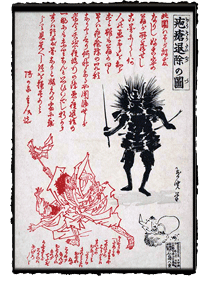 By the mid-Meiji period, vaccination
was widespread, by virtue of governmental decree. However, a late nineteenth-century hōsō-e suggests that despite
these efforts, earlier faith in the power of folk deities was not completely
eradicated. Dated to 1890, the
print shows a pair of figures heavily dotted with red pockmarks running from an
angry looking black demon equipped with a bow and arrow. Titled "Suppression of Smallpox" (Hōsō taiji no zu), the print
bears an inscription (in red) explaining that the artist saw a similar picture
in an old collector's home and was told that it protected against smallpox;
thinking it might help prevent an epidemic, he recreated it for his print
publisher. By the mid-Meiji period, vaccination
was widespread, by virtue of governmental decree. However, a late nineteenth-century hōsō-e suggests that despite
these efforts, earlier faith in the power of folk deities was not completely
eradicated. Dated to 1890, the
print shows a pair of figures heavily dotted with red pockmarks running from an
angry looking black demon equipped with a bow and arrow. Titled "Suppression of Smallpox" (Hōsō taiji no zu), the print
bears an inscription (in red) explaining that the artist saw a similar picture
in an old collector's home and was told that it protected against smallpox;
thinking it might help prevent an epidemic, he recreated it for his print
publisher.
In other words, "modern" Japanese knew that this sort of talisman was outdated --
a relic of the past — but might still hedge his bets by employing one of the
charms if the need arose.
Measles
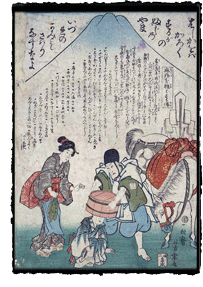 Unlike the hōsō-e, the hashika-e, or measles pictures, are less
talismans or charms themselves than a kind of pictorial guide to the magical
practices most likely to lessen the symptoms of disease. One print from the collection shows a young
boy kneeling down while a Shinto priest, dressed in white, places a wooden
bucket over his head. The sacred
white horse of Ise shrine, bearing paper strips on his back stands to the
right, and the child's mother looks on from the left. In her hand is a giant holly leaf (tarayō), thought to have protective
powers. Unlike the hōsō-e, the hashika-e, or measles pictures, are less
talismans or charms themselves than a kind of pictorial guide to the magical
practices most likely to lessen the symptoms of disease. One print from the collection shows a young
boy kneeling down while a Shinto priest, dressed in white, places a wooden
bucket over his head. The sacred
white horse of Ise shrine, bearing paper strips on his back stands to the
right, and the child's mother looks on from the left. In her hand is a giant holly leaf (tarayō), thought to have protective
powers.
Behind the figures appears an image of Mt.
Fuji, again associated
with the ability to prevent or cure pox-like diseases. The accompanying text offers a tale about
measles, and a useful list of "do's and don'ts" divided into beneficial foods (kanpyo, or dried gourd, sweet potatoes,
and so on) and things to avoid (both bathing and eating soba were to be avoided for 75 days!).
|

